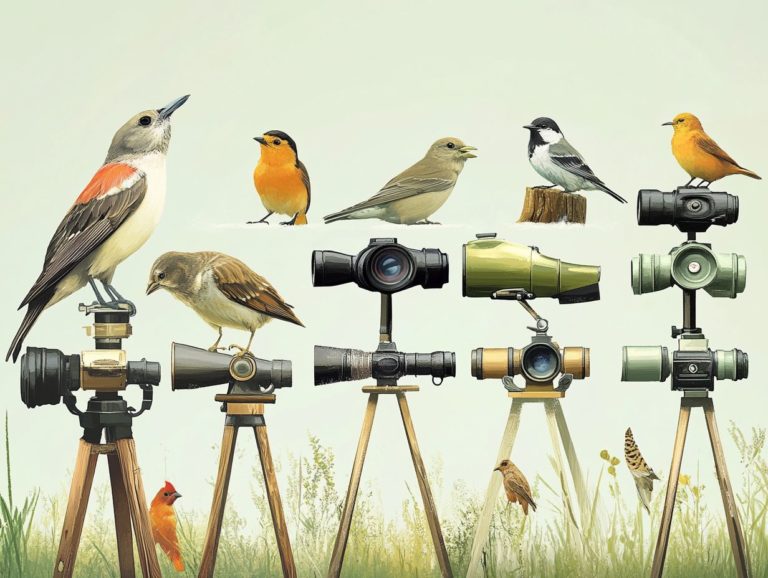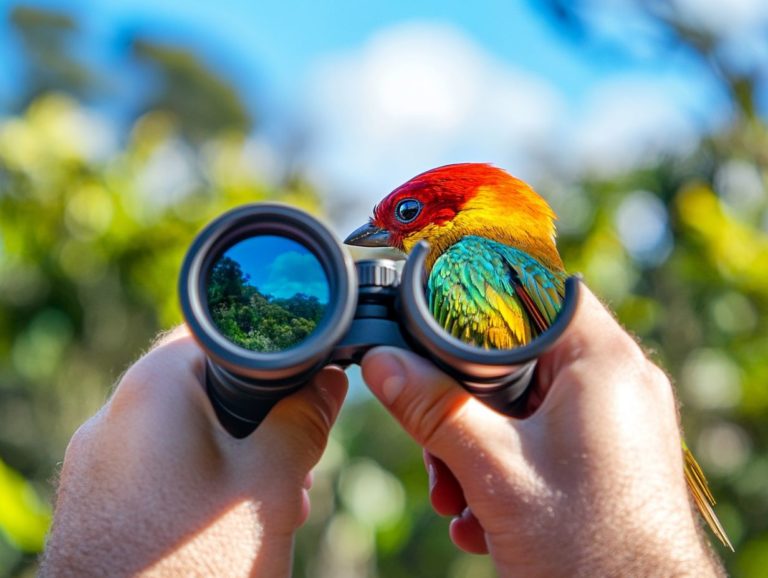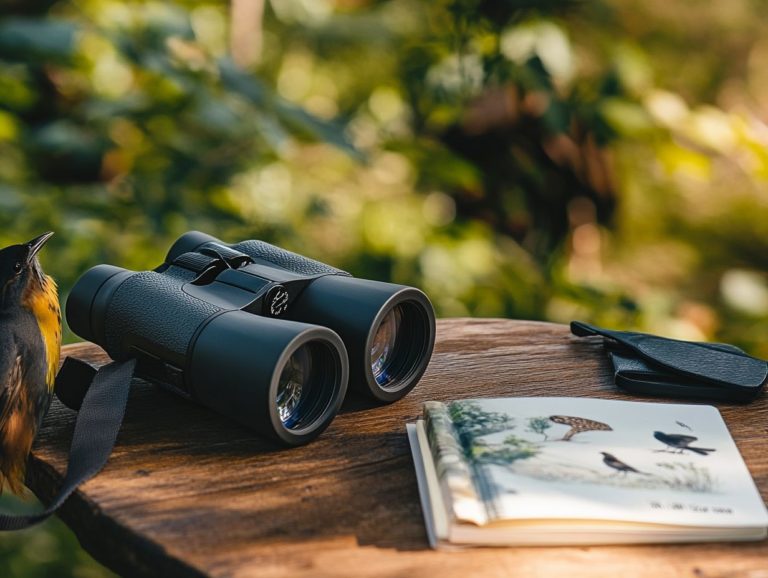The Impact of Prism Type on Birding Binoculars
When it comes to birdwatching, the right binoculars will elevate your experience. One key factor influencing their performance is the type of prism used. This article delves into the various prism types specifically roof prisms and porro prisms showcasing their unique features and how they impact your viewing experience.
Whether you’re an experienced birder or just beginning your journey, understanding these distinctions will boost your clarity and enjoyment instantly! You’ll also find essential tips on maintaining your binoculars to ensure they remain in peak condition.
Get ready to uncover how selecting the right prism type can transform your birding adventures!
Contents
- Key Takeaways:
- Unlocking the Secrets of Prism Types in Binoculars
- Roof Prisms vs. Porro Prisms
- Choosing the Right Prism Type for Birding
- Benefits of Using the Right Prism Type
- Maintenance and Care for Prism Type
- Frequently Asked Questions
- What should I consider when choosing between roof and porro prism binoculars for birding adventures?
- How does the prism type affect the overall performance of birding binoculars?
- Are roof prism binoculars better for birding than porro prism binoculars?
- Which prism type is best for birding in low light conditions?
- Do prism coatings affect the performance of birding binoculars?
- Can I switch between prism types on my birding binoculars?
Key Takeaways:
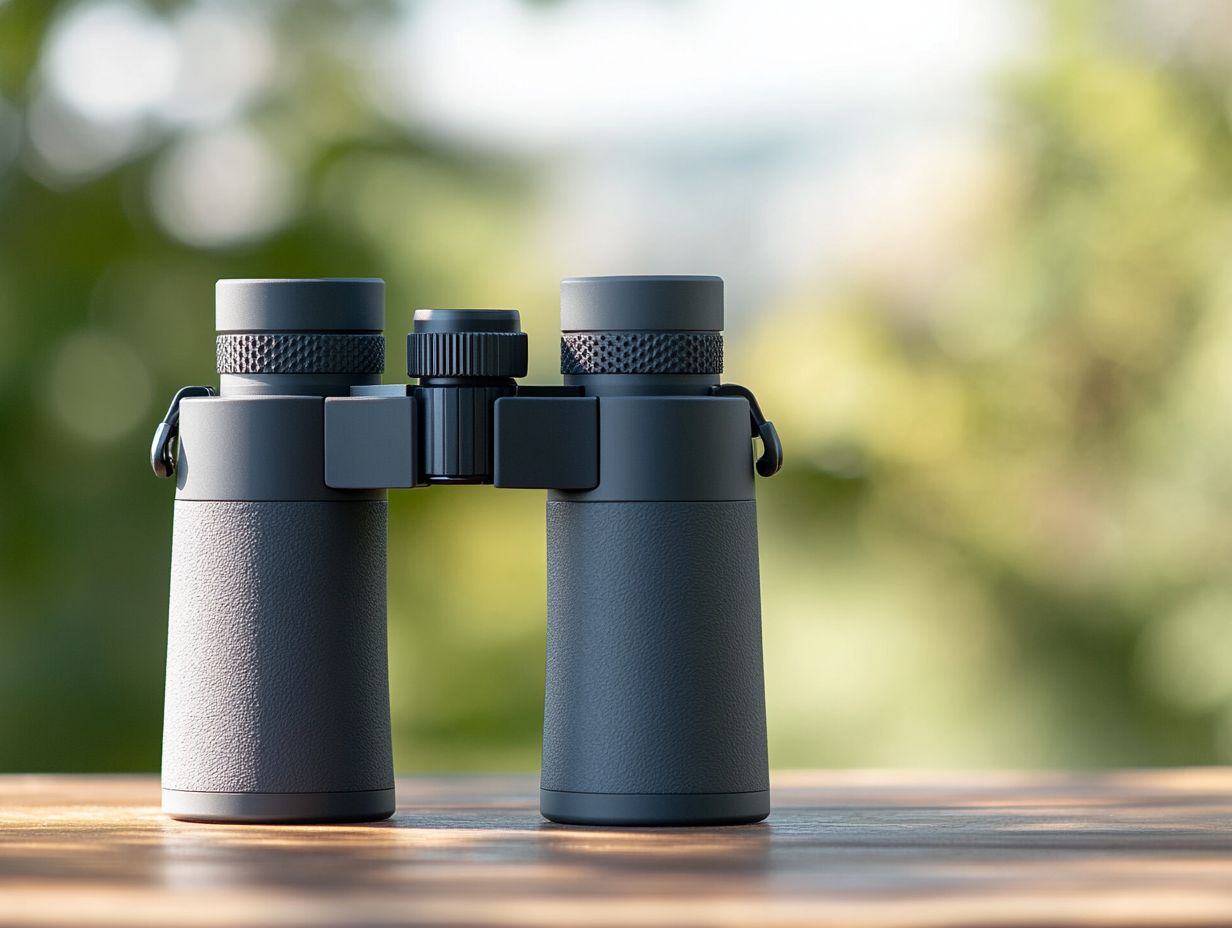
- The type of prisms used in birding binoculars greatly impacts the overall viewing experience, with roof prisms offering superior clarity and performance compared to porro prisms.
- When choosing the right prism type, consider your birding environment and specific needs to ensure optimal viewing capability and long-term cost savings.
- Proper maintenance and care of your binoculars, especially the prisms, is crucial for preserving performance and longevity. Regular cleaning and careful handling can extend their lifespan.
Unlocking the Secrets of Prism Types in Binoculars
Understanding the different prism types in binoculars is vital for you as a birding enthusiast looking to enhance your viewing experience. Prisms play a crucial role in the way binoculars are designed to help you see better, affecting key elements like image quality, light transmission, and overall ergonomics.
The two most prevalent prism systems BK7 (a type of glass that offers good light transmission) and BAK4 each present unique advantages in optical quality and efficiency. Familiarity with these systems is particularly important when selecting binocular power, whether it’s 8×42 (indicating an 8x magnification and a 42mm objective lens), 7×42, or 10×42, as they significantly influence factors such as minimum focus distance and field of view.
What are Prisms and How Do They Work?
Prisms are remarkable optical devices that bend light, allowing you to enjoy a correctly oriented view of images when using binoculars. Without these clever components, distant objects could appear inverted, making your viewing experience less than ideal.
In binoculars, prisms are essential for enhancing light transmission. They expertly manipulate the light waves passing through, ensuring that images are not only oriented correctly but also retain exceptional optical quality. The type of prism you encounter be it Schmidt-Pechan or Porro can significantly affect the design’s compactness and the clarity of the image you see.
Your choice of prism design can directly influence your overall image quality, impacting brightness and contrast two crucial elements for a truly satisfying viewing experience.
Roof Prisms vs. Porro Prisms
Roof prisms and porro prisms are foundational designs in binocular technology, each presenting distinct advantages and disadvantages tailored to specific applications.
Roof prisms are compact and lightweight, making them the perfect choice for birding enthusiasts who prioritize portability. In contrast, porro prisms typically offer a wider field of view and superior optical quality. Grasping these differences gives you the power to make informed decisions when shopping for binoculars at retailers like B&H Photo.
Considering ergonomics is crucial; it can greatly enhance your experience during long periods of observation.
Comparison of Features and Performance
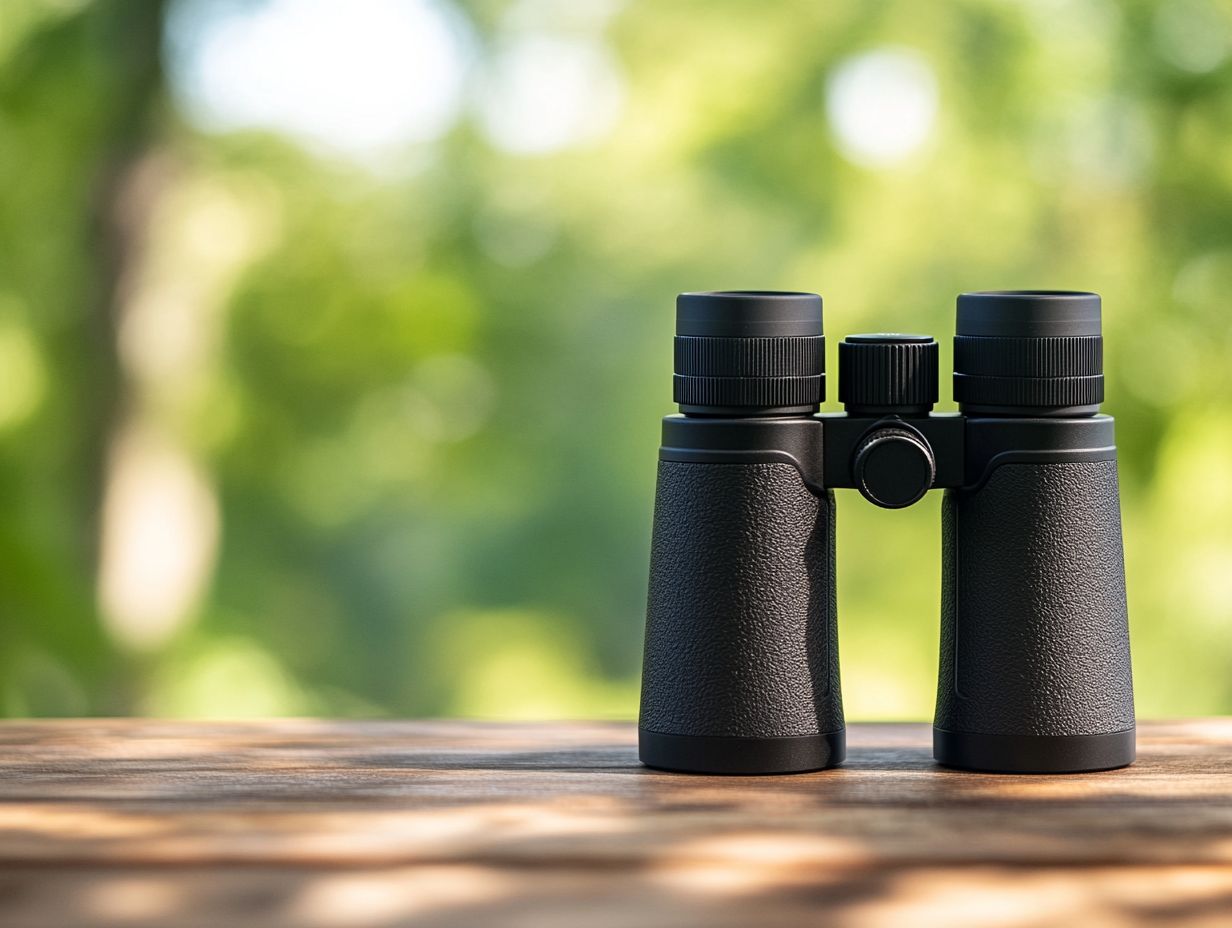
When comparing features and performance, roof prisms and porro prisms showcase distinct characteristics that shape your birding experience.
Roof prisms offer a compact and lightweight design, perfect for fieldwork where ease of transport is essential. Porro prisms, however, provide superior depth perception and a wider field of view, enhancing your observation of bird movements, especially in thick foliage.
In terms of image quality, porro prisms deliver brighter images at lower magnifications, giving you a vibrant view during daylight outings. Roof prisms work well in low-light conditions, offering versatility for early morning or dusk birdwatching adventures.
Your choice between these two types depends on your specific needs whether you prioritize portability or enhanced depth perception while searching for elusive species.
Choosing the Right Prism Type for Birding
Choosing the right prism type can transform your birding adventures! Consider factors like ergonomics, field of view, and light transmission (how well the binoculars let in light) to understand the importance of the right equipment for capturing fleeting moments.
You need to weigh the benefits of roof and porro prisms carefully. Your environment, distance to subjects, and personal preferences will guide you in deciding between a compact, lightweight roof prism model or the more traditional, wider-field porro prism binoculars.
By understanding your unique birding needs, you ll make informed choices when shopping for binoculars, enhancing your viewing experience.
Considerations for Birding Environments and Needs
When on the hunt for the best prism type, consider your specific environments and unique needs.
Evaluate different birding settings like dense forests, open fields, wetlands, or coastal areas, each presenting its own challenges. In woodlands where light filters through the leaves, you might prefer binoculars that excel in light gathering. In this case, roof prisms could be your best bet due to their compact design and user-friendly handling.
On the flip side, if you find yourself in wide-open fields under bright sunlight, portability becomes key. Here, lightweight porro prisms shine, offering comfort and a broader field of view.
Your individual preferences matter too. While some may prioritize lightness and convenience, others might focus on functionality and optical clarity. By considering all these factors, you can choose the prism type that aligns with your birdwatching needs and improves your overall experience.
Benefits of Using the Right Prism Type
Choosing the right prism type for your binoculars can greatly enhance clarity and your overall experience as a birding enthusiast. The decision between roof prisms and porro prisms directly impacts image quality, light transmission, and your ability to focus on subjects at different distances.
By selecting binoculars with the appropriate prism type, you can enjoy clearer images, enhanced light-gathering capabilities, and superior ergonomics for long hours in the field. Understanding these advantages lets you make the most of your time outdoors, spotting and identifying various bird species easily.
Explore different prism types to find your perfect binoculars!
Improved Clarity and Viewing Experience
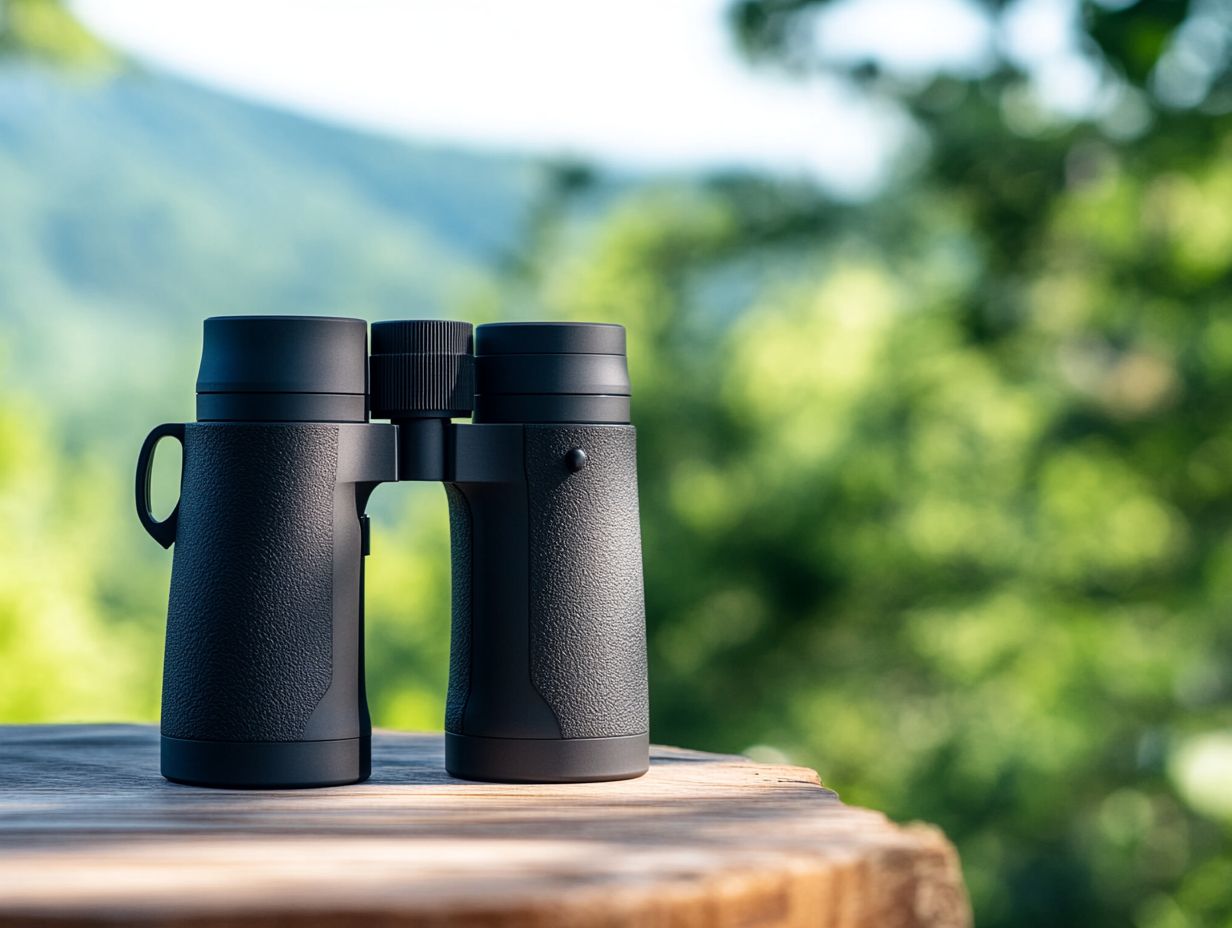
Choosing the right prism type for your binoculars offers a major advantage: enhanced clarity that elevates your entire viewing experience.
This improvement directly impacts how you perceive fine details like intricate feather patterns and subtle color variations. It becomes easier to identify various bird species in their natural environments. For example, roof prisms provide a sleek, compact design without compromising how well you see through them, which is especially beneficial during long birding excursions.
With clearer images, your ability to make accurate identifications skyrockets. Casual sightings transform into moments of genuine awe and appreciation for the avian world.
This clarity enriches the identification process and amplifies the joy of each birding trip. It allows you to fully immerse yourself in the captivating beauty of nature.
Long-Term Cost Savings
Investing in high-quality binoculars with the right prism type can lead to significant long-term savings. Well-crafted optics typically need less frequent replacement and maintenance.
This is especially advantageous for birdwatchers who depend on their gear for extended periods. With durable materials and exceptional construction, these binoculars are built to endure outdoor challenges, greatly reducing wear and damage risks.
Selecting a well-made pair of optics elevates your viewing experience and lessens the financial strain from constant upgrades or repairs. The initial investment in quality binoculars yields impressive returns in both enjoyment and practicality, making them a smart choice for those passionate about exploring the wonders of the natural world.
Maintenance and Care for Prism Type
Proper maintenance and care are essential for enhancing the longevity of your binoculars, especially regarding the specific prism type used in their design.
Understanding and addressing the unique needs of your binoculars will keep them in optimal condition for years to come.
Tips for Keeping Your Binoculars in Optimal Condition
Follow these tips to keep your binoculars performing like new!
Regular cleaning is key, especially for the lenses and exterior surfaces. Dirt and smudges can significantly compromise your image quality. When it’s time to clean, use a soft lens cloth and, if needed, a specialized lens cleaner to avoid scratches.
Proper storage is equally crucial. Using a padded case protects your binoculars from impacts and prevents dust accumulation. Tailor your care based on the type of prism. Roof prism models may require extra attention regarding compactness and weatherproof features, while Porro prism binoculars could benefit from more frequent alignment maintenance.
Incorporating these practices can significantly enhance the durability and overall viewing experience of your binoculars.
Frequently Asked Questions
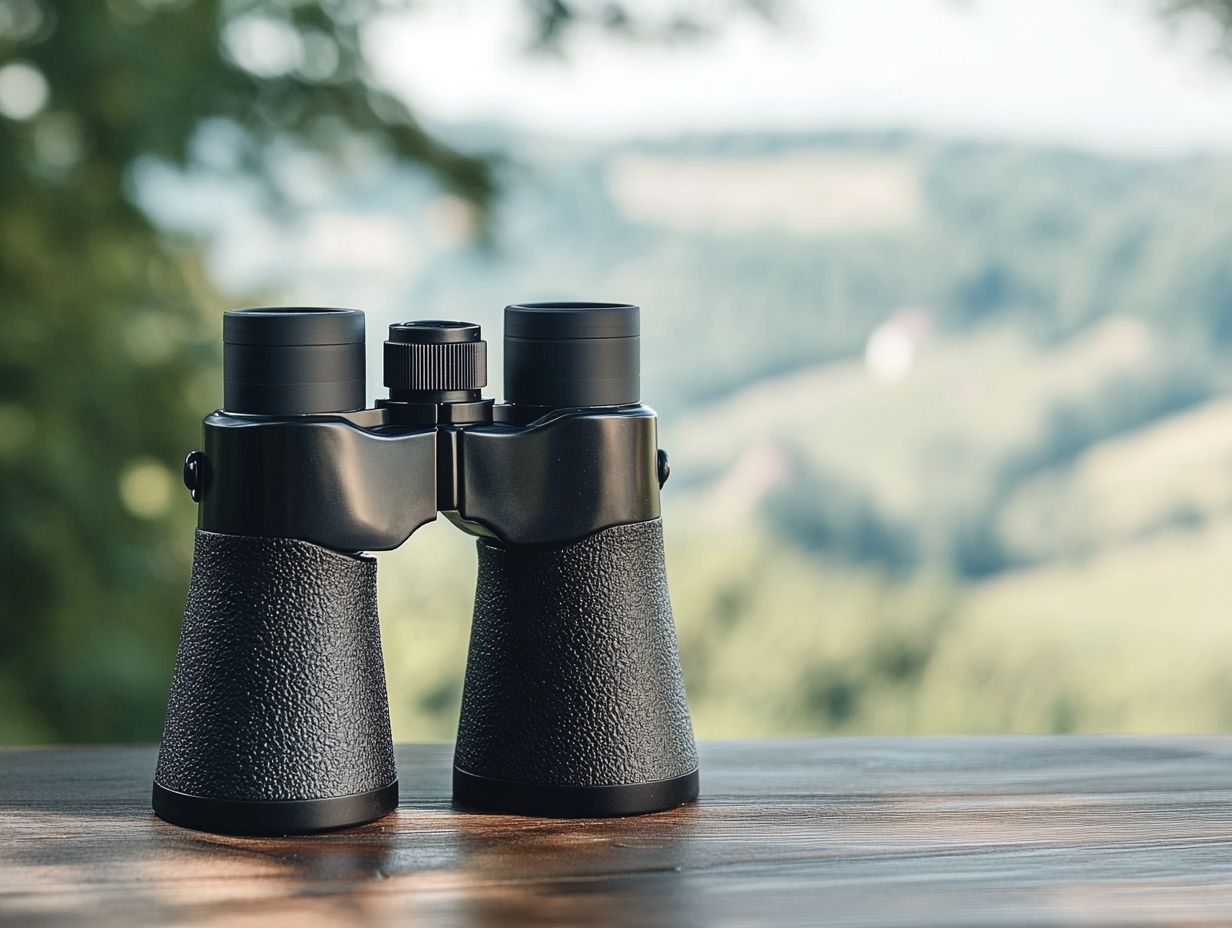
What should I consider when choosing between roof and porro prism binoculars for birding adventures?
Roof prism binoculars have a straight-through design, while Porro prism binoculars have an offset design. This means the lenses in roof prism binoculars are aligned, whereas the lenses in Porro prism binoculars are not.
How does the prism type affect the overall performance of birding binoculars?
The prism type significantly impacts light transmission, image quality, and durability. Each type has its pros and cons, so consider your specific needs when choosing a prism type.
Explore your binocular options today and share your birding experiences with us!
Are roof prism binoculars better for birding than porro prism binoculars?
Not necessarily. Roof prism binoculars are compact and streamlined. Porro prism binoculars provide better depth perception and a wider field of view.
Which prism type is best for birding in low light conditions?
Roof prism binoculars usually have better light transmission. This makes them a great choice for birding in low light. Some high-quality porro prism binoculars can also perform well in low light.
Do prism coatings affect the performance of birding binoculars?
Yes! Prism coatings can greatly impact image quality and brightness. High-quality coatings, such as those that enhance clarity and maximize light, improve light transmission and reduce glare.
Can I switch between prism types on my birding binoculars?
No, you can’t change the prism type as it’s built into the design! Want to switch prism types? You ll need to buy a new pair of binoculars!

